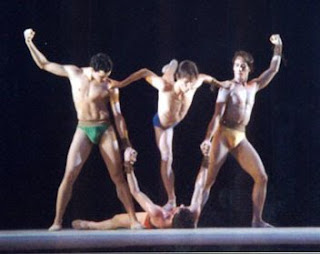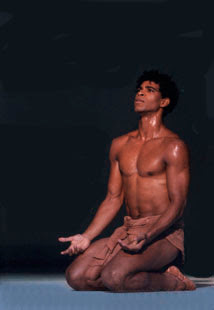Performances by principal dancers of the Royal Ballet of 
With the Prima Ballerina Assoluta Alicia Alonso, escorted by the international ranking Cuban dancers Carlos Acosta and Jose Manuel Carreno, concluded last night XXII International Ballet Festival of 
At the conclusion of the closing ceremony, the director of the Ballet Nacional de Cuba (BNC) came forward to acknowledge a long ovation that paid tribute to his 90 years of life dedicated to her homeland.
 The performance in the Gran Teatro de La Habana was distinguished by the variety and excellence of the 12 choreographies presented and the supreme quality of Cuban and foreign performers, who brought to this event his art from places like London, New York, Buenos Aires , Berlin and Madrid.
The performance in the Gran Teatro de La Habana was distinguished by the variety and excellence of the 12 choreographies presented and the supreme quality of Cuban and foreign performers, who brought to this event his art from places like London, New York, Buenos Aires , Berlin and Madrid.
The Oct. 28-Nov. 7 festival was dedicated to Cuban prima ballerina assoluta Alicia Alonso, for her 90th birthday, and the last two days were chock full of delights.
 It was nice to see the return of pieces of classic repertoire of the BNC: The Grand Pas de Quatre, choreography by Alicia, and the Four Treasures of the BNC danced in their time so unique, but this time, taken by another promising generation of young ballerinas, and Canto vital, Plisetski Azari, a fledgling male cast but effective.
It was nice to see the return of pieces of classic repertoire of the BNC: The Grand Pas de Quatre, choreography by Alicia, and the Four Treasures of the BNC danced in their time so unique, but this time, taken by another promising generation of young ballerinas, and Canto vital, Plisetski Azari, a fledgling male cast but effective.
Among the visitors to the Spanish excelled Tamara Rojo, the Royal Ballet of London, who in Five Brahms Waltzes in the manner of Isadora Duncan, brought the scene the spirit of that legendary dancer of the early twentieth century, with a very personal lyricism that all dazzled.
 For their bravery and gracefulness, Roberta Marquez and Steven McRae, from the Royal Ballet of London, who waged a difficult and impeccable technique as if it were the most natural thing in the world in the pas de deux from Sleeping Beauty, gained public favor.
For their bravery and gracefulness, Roberta Marquez and Steven McRae, from the Royal Ballet of London, who waged a difficult and impeccable technique as if it were the most natural thing in the world in the pas de deux from Sleeping Beauty, gained public favor.
Two winners of the choreography contest were performed as well: Espectral, by Cuban Maysabel Pintado, and by Spaniards Elias Aguirre and Alvaro Esteban: Entomo, whose world premiere took place on Saturday in the García Lorca Hall of the GTH. An original, contemporary vocabulary, the first, and a boundless field of creativity that sparked one of the strongest ovations of the festival, the second, were those moments of pure dance.
The program also included principal dancers from the National Ballet of Cuba, Bárbara García and Javier Torres, in A Rose for Miss Emily by Agnes de Mille, inspired by the William Faulkner short story, and principals Viengsay Valdés and Elier Bouzac in The Magic Flute, by Alicia Alonso.
 The stars of the Ballet Teatro Colon, Argentina, Nadia Muzyca and Juan Pablo Ledo, turned to the prestige of this institution with Encuentro, choreographed by Lidia Segni, the immortal music of Astor Piazzolla, whose feints and sensuality, rose to great art.
The stars of the Ballet Teatro Colon, Argentina, Nadia Muzyca and Juan Pablo Ledo, turned to the prestige of this institution with Encuentro, choreographed by Lidia Segni, the immortal music of Astor Piazzolla, whose feints and sensuality, rose to great art.
Another climax was Doble sentir, choreographed by Antonio El Pipa, danced by himself, who skilfully reminded us how much Cuban culture roots are in
Samsara, one of the newest creations of the Spanish choreographer Victor Ullate, was shown to the Cuban public on the Closing Gala of the Festival too.
In the work 18 dancers dance in a ritual intended approach to spirituality,
through a dialogue between Eastern and Western culture that is emerging from ethnic rhythms composed from Iran, India, Egypt, Nepal, China and Japan.
Samsara is defined by its creator as a dance of life and his artistic testament, through the emotion and beauty product of the combination of steps, music and phrases designed to express the spirit of liberation.
 One of the best moments in the night was the solo Two, by Carlos Acosta, the guest dancer from the Royal Ballet of London, who was distinguished by a manly and poetic plasticity, enhanced by skylights that shaped his topless as a living statue classic scene that squandered a unique image of his shoulders, shoulder blades and arms.
One of the best moments in the night was the solo Two, by Carlos Acosta, the guest dancer from the Royal Ballet of London, who was distinguished by a manly and poetic plasticity, enhanced by skylights that shaped his topless as a living statue classic scene that squandered a unique image of his shoulders, shoulder blades and arms.
Carreño also did enjoy an audience enraged with another solo, Sinatra Suite, elegant choreography by Twyla Tharp enhanced by the voice of the best crooner of American song.
The Gala left us in readiness for the next meeting, within two years of this universal feast of ballet.






No hay comentarios:
Publicar un comentario